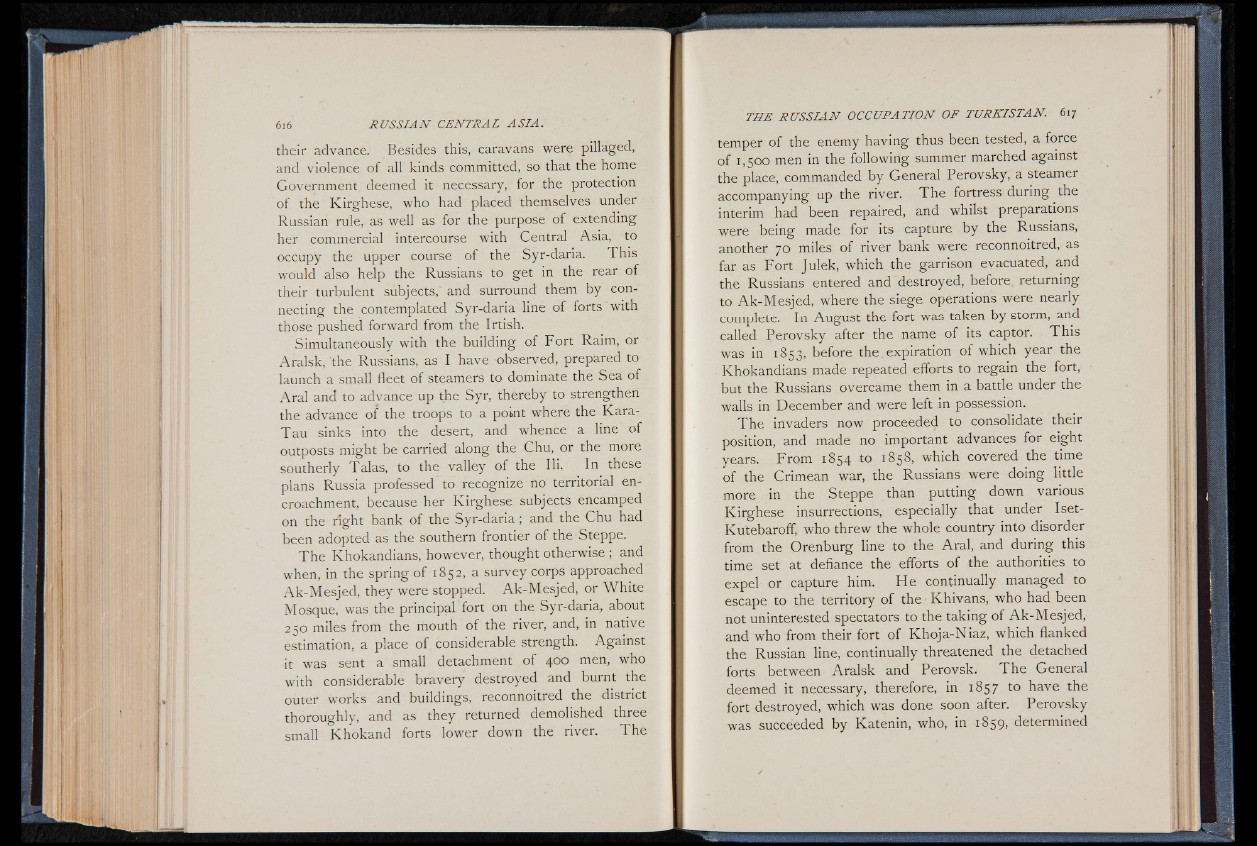
their advance. Besides this, caravans were pillaged,
and violence of all kinds committed, so that the home
Government deemed it necessary, for the protection
of the Kirghese, who had placed themselves under
Russian rule, as well as for the purpose of extending
her commercial intercourse with Central Asia, to
occupy the upper course of the Syr-daria. This
would also help the Russians to get in the rear of
their turbulent subjects,' and surround them by connecting
the contemplated Syr-daria line of forts with
those pushed forward from the Irtish.
Simultaneously with the building of Fort Raim, or
Aralsk, the Russians, as I have -observed, prepared to
launch a small fleet of steamers to dominate the Sea of
Aral and to advance up the Syr, thereby to strengthen
the advance of the troops to a point where the Kara-
Tau sinks into the desert, and whence a line of
outposts might be carried along the Chu, or the more
southerly Talas, to the valley of the Ili. In these
plans Russia professed to recognize no territorial encroachment,
because her Kirghese subjects encamped
on the right bank of the Syr-daria; and the Chu had
been adopted as the southern frontier of the-Steppe.
The Khokandians, however, thought otherwise ; and
when, in the spring of 1852, a survey corps approached
Ak-Mesjed, they were stopped. Ak-Mesjed, or White
Mosque, was the principal fort on the Syr-daria, about
250 miles from the mouth of the river, and, in native
estimation, a place of considerable strength. Against
it was sent a small detachment of 400 men, who
with considerable bravery destroyed and burnt the
outer works and buildings, reconnoitred the district
thoroughly, and as they returned demolished three
small Khokand forts lower down the river. The
temper of the enemy having thus been tested, a force
of 1,500 men in the following summer marched against
the place, commanded by General Perovsky, a steamer
accompanying up the river. The fortress during the
interim had been repaired, and whilst preparations
were being made for its capture by the Russians,
another 70 miles of river bank were reconnoitred, as
far as Fort Julek, which the garrison evacuated, and
the Russians entered and destroyed, before, returning
to Ak-Mesjed, where the siege operations were nearly
complete. In August the fort was taken by storm, and
called Perovsky after the name of its captor. This
was in 1853, before the expiration of which year the
Khokandians made repeated efforts to regain the fort,
but the Russians overcame them in a battle under the
walls in December and were left in possession.
The invaders now proceeded to consolidate their
position, and made no important advances for eight
years. From 1854 to 1858, which covered the time
of the Crimean war, the Russians were doing little
more in the Steppe than putting down various
Kirghese insurrections, especially that under Iset-
Kutebaroff, who threw the whole country into disorder
from the Orenburg line to the Aral, and during this
time set at defiance the efforts of the authorities to
expel or capture him. He continually managed to
escape to the territory of the Khivans, who had been
not uninterested spectators to the taking of Ak-Mesjed,
and who from their fort of Khoja-Niaz, which flanked
the Russian line, continually threatened the detached
forts between Aralsk and Perovsk. The General
deemed it necessary, therefore, in 1857 to have the
fort destroyed, which was done soon after. Perovsky
was succeeded by Katenin, who, in 1859, determined